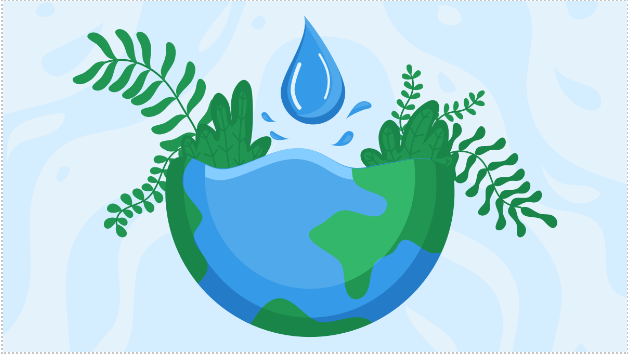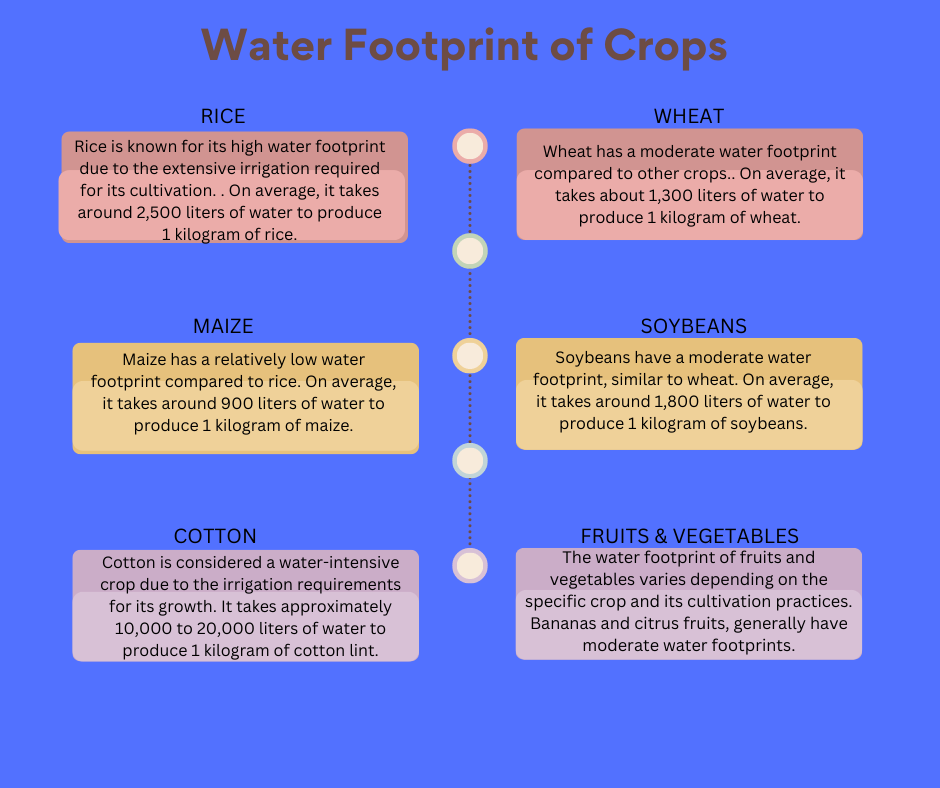Contact: +91 99725 24322 |
Menu
Menu
Quick summary: Discover the key to sustainable agriculture with effective water conservation practices. Learn how water management strategies and innovative solutions contribute to resource preservation, increased efficiency, and environmental sustainability. Explore the benefits of water conservation for sustainable agriculture in our informative blog.

Water conservation in sustainable agriculture is more than just a good practice; it’s a necessity. As farmers face increasing challenges like water scarcity and climate change, the need to efficiently manage and preserve this vital resource has never been more urgent. Without proper water conservation, the very foundation of our food systems is at risk, leaving farmers struggling to maintain productivity while protecting the environment.
According to FAO, it is estimated that around 80% of global freshwater withdrawals are used for agriculture demonstrating the crucial role of water in food production.
Water conservation for sustainable agriculture is a fundamental component , promoting efficient resource usage, environmental stewardship, and long-term food security. By embracing water conservation strategies, farmers can reduce their water footprint, minimize environmental impacts, and contribute to a more sustainable future. So, how can sustainable agriculture rise to the challenge and secure water for the future? Let’s explore the strategies that make it possible.
Key Takeaways
According to National Oceanic and Atmospheric Administration(NOAA), approximately 97.5% of earth’s water is in the form of saltwater found in oceans, seas and saline groundwater.
The water cycle, also known as the hydrological cycle, is a continuous process that circulates water between the Earth’s surface, atmosphere, and underground reservoirs. It plays a vital role in agriculture as it governs the availability of water for crops, soil moisture levels, and overall agricultural productivity.
In agriculture: Evaporation from soil surfaces and plant leaves (transpiration) contributes to the overall loss of water from agricultural fields. High temperatures and wind can increase evaporation rates, leading to increased water demand for crops.
In agriculture: Condensation plays a role in precipitation, which is crucial for providing water to crops.
In agriculture: Precipitation is a primary source of water for agriculture. Adequate and evenly distributed rainfall is crucial for crop growth and can reduce the reliance on irrigation. Insufficient precipitation or irregular rainfall patterns can lead to droughts, crop failure, and water stress for farmers.
In agriculture: Infiltration and percolation contribute to soil moisture, which is critical for crop root uptake and overall plant health. The ability of soil to absorb and retain water affects irrigation needs, water availability, and nutrient cycling in agriculture.
In agriculture: Surface runoff can lead to soil erosion, carrying away valuable topsoil and nutrients. It can also cause water pollution by carrying agricultural chemicals and sediments into water bodies, adversely impacting ecosystems and water quality.
In agriculture: Transpiration is essential for plant growth and nutrient uptake. It helps regulate plant temperature and maintains cell turgor, influencing crop productivity. Proper irrigation management ensures an adequate water supply to meet the transpiration needs of crops.
The water cycle, also known as the hydrological cycle, is a continuous process that circulates water between the Earth’s surface, atmosphere, and underground reservoirs. It plays a vital role in agriculture as it governs the availability of water for crops, soil moisture levels, and overall agricultural productivity.
The water footprint of crops refers to the total volume of water consumed or used throughout their entire production process, including irrigation, rainwater, and water used in processing or manufacturing. It provides insights into the amount of water required to produce a specific crop, helping us understand the water intensity of different agricultural products.

Understanding the water footprint of different crops is essential for sustainable water management in agriculture. The water footprint provides insights into the amount of water consumed throughout the entire production process, including irrigation and processing. By examining the water intensity of various crops, we can make informed decisions to promote water conservation for sustainable agriculture.
Water conservation is a cornerstone of sustainable farm management, as it ensures the efficient use of a critical resource while minimizing environmental impact. By implementing water-saving techniques such as drip irrigation, rainwater harvesting, and soil moisture management, farms can significantly reduce water wastage and enhance crop productivity. These practices not only preserve vital water resources but also improve soil health and reduce the need for synthetic inputs, which can further lower the farm’s carbon footprint. Effective water management supports farm resilience against climate variability and promotes long-term sustainability by balancing productivity with ecological stewardship. Ultimately, integrating water conservation into farm management practices helps create a more resilient and environmentally responsible agricultural system.
Water conservation is pivotal in building low-carbon agriculture supply chains because it directly impacts several environmental factors. By optimizing water use, farms and businesses reduce their reliance on energy-intensive irrigation and water treatment systems, leading to lower carbon emissions. Additionally, sustainable water practices help preserve natural ecosystems and soil health, which in turn enhances carbon sequestration. This not only mitigates the carbon footprint of agricultural operations but also supports resilience against climate extremes, reducing the need for carbon-intensive interventions.
Sustainable irrigation aims to maximize water-use efficiency, minimize water loss, and protect water quality. Let’s explore various sustainable irrigation practices that contribute to water conservation, preserve ecosystems, and ensure long-term agricultural productivity.
Drip irrigation is a highly efficient irrigation method that delivers water directly to the plant root zone. By minimizing water loss through evaporation and runoff, it maximizes water-use efficiency. Drip irrigation systems use a network of tubes and emitters to deliver water slowly and precisely, reducing water wastage and optimizing plant uptake.
Alternate Wet and Drying (AWD) is a management practice in irrigated lowland rice that saves water and also reduces greenhouse gas emissions while maintaining yields. It involves periodic drying and reflooding of rice fields.
Modern sprinkler systems equipped with precision nozzles and pressure regulators can distribute water evenly across the field, minimizing overspray and reducing water loss due to wind drift. By matching irrigation rates to crop water requirements, precision sprinklers help conserve water while maintaining optimal soil moisture levels.
Using soil moisture sensors, farmers can accurately monitor soil moisture content and adjust irrigation schedules accordingly. These sensors provide real-time data on soil moisture levels, helping farmers determine when and how much water to apply. This approach prevents overwatering, reduces water waste, and prevents waterlogged soils.
Developing effective irrigation schedules based on crop water needs and local climate conditions is crucial for sustainable water management. By considering factors such as evapotranspiration rates, rainfall patterns, and soil characteristics, farmers can optimize irrigation timing and frequency, ensuring water is used efficiently without compromising plant health.
Applying organic or synthetic mulch to the soil surface conserves moisture by reducing evaporation and suppressing weed growth. Mulch acts as a protective layer that shields the soil from direct sunlight and wind, keeping it cooler and preventing water loss. It also improves soil structure, promotes nutrient retention, and reduces erosion.
Rainwater harvesting systems capture and store rainfall for later use in irrigation. By collecting rainwater from rooftops, land surfaces, or storage ponds, farmers can supplement their irrigation needs while reducing dependence on freshwater sources. Rainwater harvesting also helps recharge groundwater and reduces pressure on local water supplies.
Sustainable agriculture practices and water conservation go hand in hand, creating a harmonious approach to farming that benefits both crops and the environment. Techniques like drip irrigation and soil moisture monitoring optimize water use, reduce waste, and enhance soil health. Implementing practices such as mulching and cover cropping further conserves water, minimizes erosion, and supports overall ecosystem health. By adopting these water-efficient strategies, farmers can not only improve their yields but also contribute to long-term environmental sustainability, ensuring that water resources are preserved for future generations.
Sustainable irrigation practices are essential for responsible water management in agriculture. By implementing techniques such as drip irrigation, precision sprinklers, soil moisture monitoring, and rainwater harvesting, farmers can reduce water waste, improve water-use efficiency, and preserve valuable water resources. Embracing these practices not only benefits agricultural productivity but also promotes environmental conservation and ensures a greener future for generations to come.
Technology solutions play a crucial role in tracking and enhancing sustainable water conservation practices in agriculture. These solutions provide real-time data, precise monitoring, and actionable insights that help farmers manage water resources more effectively. For instance, smart irrigation systems can automatically adjust water usage based on soil moisture levels and weather conditions, ensuring that crops receive the exact amount of water they need without any wastage. Remote sensors and IoT devices can monitor water quality and usage across the farm, enabling farmers to detect inefficiencies and make informed decisions quickly. Digital platforms also facilitate collaboration among stakeholders by providing a shared, tamper-proof record of all activities related to water management and other sustainability practices. This not only helps in optimizing resource use but also builds trust and accountability within the supply chain. By adopting blockchain platforms, farmers can ensure that their water conservation efforts are not only effective but also recognized and valued by consumers and partners, ultimately contributing to a more sustainable agricultural ecosystem.
The TraceX Sustainability Platform is designed to support these efforts by offering an integrated solution that tracks and verifies sustainable practices across the entire agricultural value chain. The platform leverages blockchain technology to ensure transparency, accuracy, and traceability of data. With TraceX, farmers and agribusinesses can monitor their water conservation efforts, document sustainable practices, and generate verifiable reports that demonstrate their commitment to sustainability.
VNV Advisory leveraged TraceX’s solutions to effectively track their Alternate Wetting and Drying (AWD) practices, a water-saving technique used in rice cultivation. By using the TraceX DMRV Platform, VNV Advisory was able to monitor real-time data on water usage and soil moisture, securely recorded on blockchain for transparency. This allowed them to quantify water savings and reductions in methane emissions, essential for carbon credit generation. TraceX’s technology ensured accurate reporting and enhanced trust among stakeholders, making their AWD practices more impactful and verifiable.
Water conservation in agriculture is closely tied to social and economic well-being. By ensuring the availability of water for irrigation, farmers can secure their livelihoods, support rural communities, and contribute to food security. Moreover, sustainable water management practices create opportunities for innovation, technology adoption, and agricultural resilience in the face of a changing climate.
In conclusion, water conservation in agriculture is essential for environmental sustainability, food security, and economic prosperity. By implementing efficient irrigation techniques, soil management practices, and embracing technological advancements, farmers can optimize water use, protect ecosystems, and ensure a sustainable future for agriculture.
Water conservation is essential in sustainable agriculture because it ensures the efficient use of a critical resource, reducing waste and preserving water for future use. By conserving water, farmers can maintain crop productivity even in times of scarcity, protect the environment, and contribute to the long-term sustainability of agricultural systems.
Effective water conservation techniques in sustainable agriculture include drip irrigation, which delivers water directly to the plant roots, rainwater harvesting for supplemental irrigation, and soil moisture monitoring to optimize watering schedules. These practices reduce water wastage, enhance soil health, and improve crop yields, all while minimizing the environmental impact.
Water conservation enhances climate resilience by making farms less vulnerable to droughts and water shortages. By efficiently managing water resources, farmers can maintain consistent crop yields despite changing weather patterns. This resilience is crucial for sustaining agricultural productivity and food security in the face of climate change.
